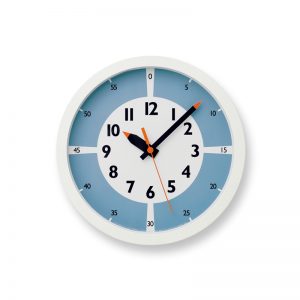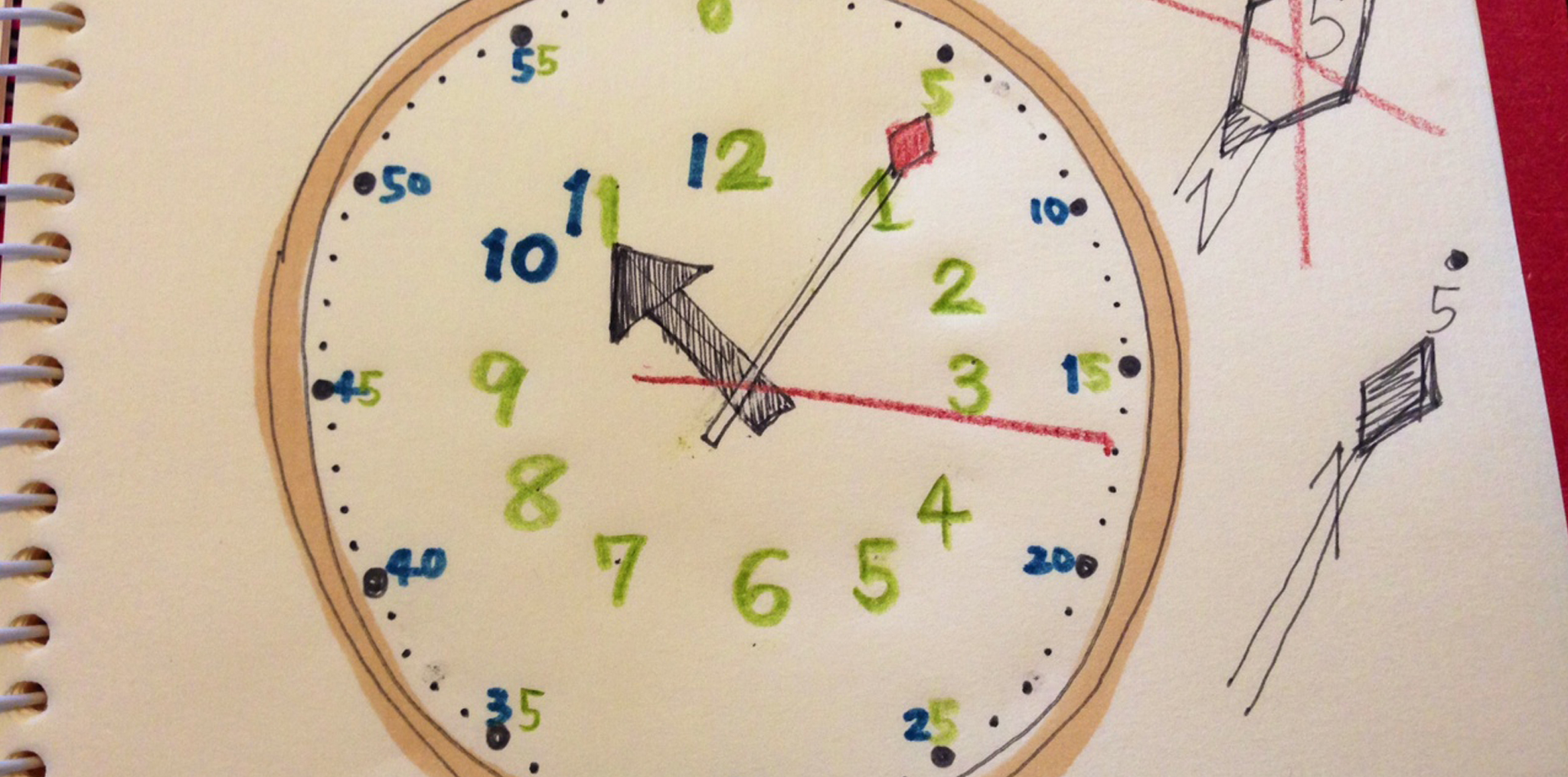
[ Design & Sentences : Yoko Dobashi ]
An analog clock that motivates children who cannot read a clock to tell the time – our “fun pun clock.”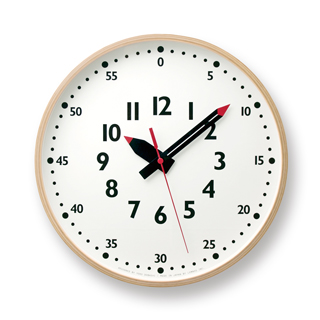
Though I started looking for clocks based on the sexagesimal system without thinking seriously, I was unable to find such a thing. When I went to a symposium to look for an aluminum processor for another purpose, I had the opportunity to listen to a discussion between Mr. Takata, a president of TAKATA Lemnos, and a designer. After an unexpected turn of events, I ended up going on a business trip to Takaoka for the first time, where the Lemnos headquarters is located. Guess what I saw in a waiting room full of various design clocks?
The second thrilling clock development story.
On my first business trip,
small talk turned out to be a big event!
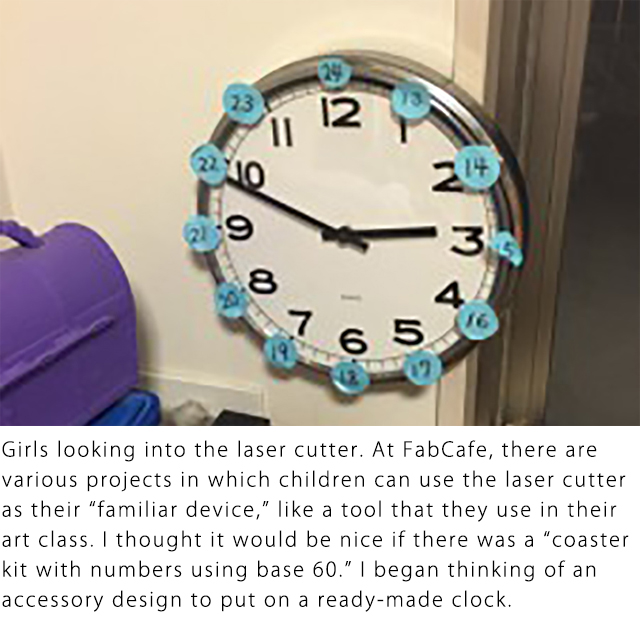 From the outset I’d had in mind the image of a clock that would be easy for children to read: “A design with numbers using base 60 on the outer display of an analog clock.”
From the outset I’d had in mind the image of a clock that would be easy for children to read: “A design with numbers using base 60 on the outer display of an analog clock.”
Regardless of how much digital has developed, an analog clock is still easier for children to understand as it visually shows “how much time they have left” by “a specified time” and helps them to intuitively understand the time with an image, like a graphic.
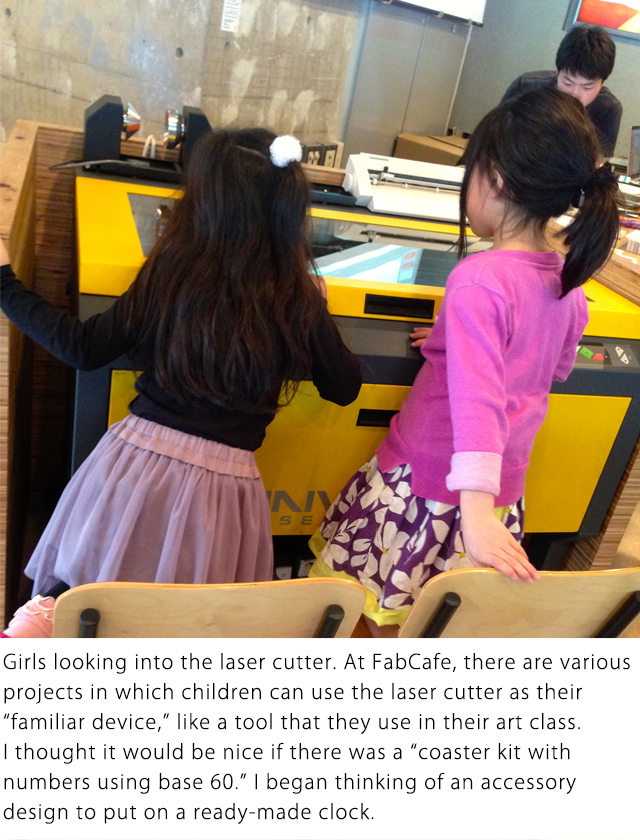 I looked in interior shops, variety stores, stationery stores, and department stores, and I searched on the Internet using my own keywords: “child kids analog clock sexagesimal duodecimal,” etc. I also checked overseas websites and educational toys, but was still unable to find what I was looking for.
I looked in interior shops, variety stores, stationery stores, and department stores, and I searched on the Internet using my own keywords: “child kids analog clock sexagesimal duodecimal,” etc. I also checked overseas websites and educational toys, but was still unable to find what I was looking for.
“If I can’t find my ideal clock, I will try to make an original clock for next year’s workshop using numeral wall stickers or corks with numbers printed on them, and then put these on the outer edge of an analog clock…” I began thinking about how I could make the original clock. And about how it might also be good to make an easy puzzle in the workshop using a laser cutter at FabCafe in Shibuya. At that time, I never considered that I would be designing a clock myself in the near future.
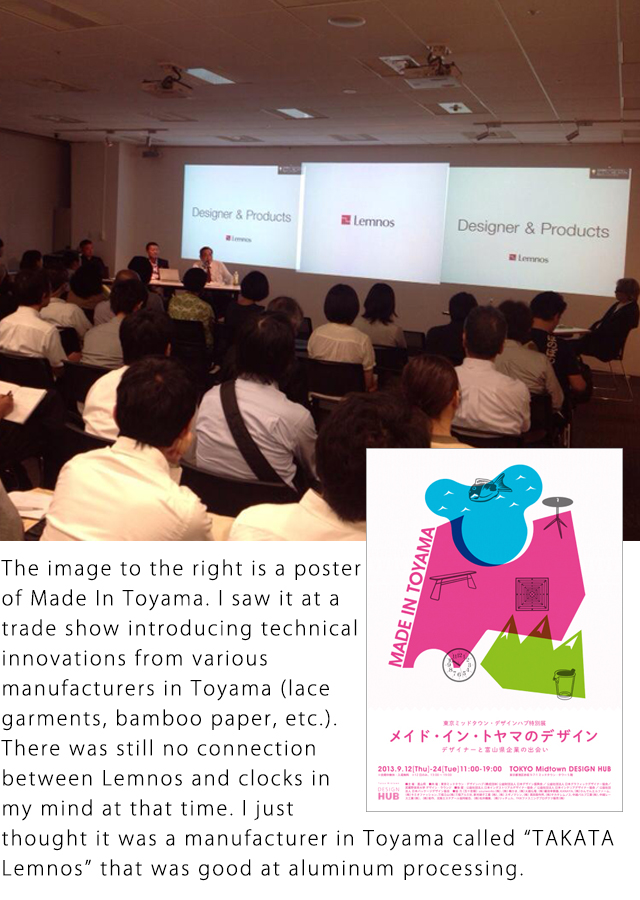 At around the same time, I was looking for a manufacturer who produced aluminum parts for another purpose.
At around the same time, I was looking for a manufacturer who produced aluminum parts for another purpose.
On Facebook, I met Mr. Kiriyama, a president of TRUNK LTD., for the first time in 10 years and asked him about it. He recommended that I attend a talk event given by the president of a company that was good at aluminum processing and a designer. I discussed it with my family and decided to go to the event, despite the fact it was being held in the evening. After the event, I stood in a long line of “people who have questions.” Finally, my turn came, and while attempting to retrieve a model from my tote bag, I asked in haste, “Could you make a prototype of this?”
“It’s best not to show something under development in front of people. Let me see it in Takaoka,” said Mr. Takata, a president of TAKATA Lemnos. My mind went blank. I am a mother. I considered it difficult to be able to go out at night, so a “business trip” was something quite unbelievable for me.
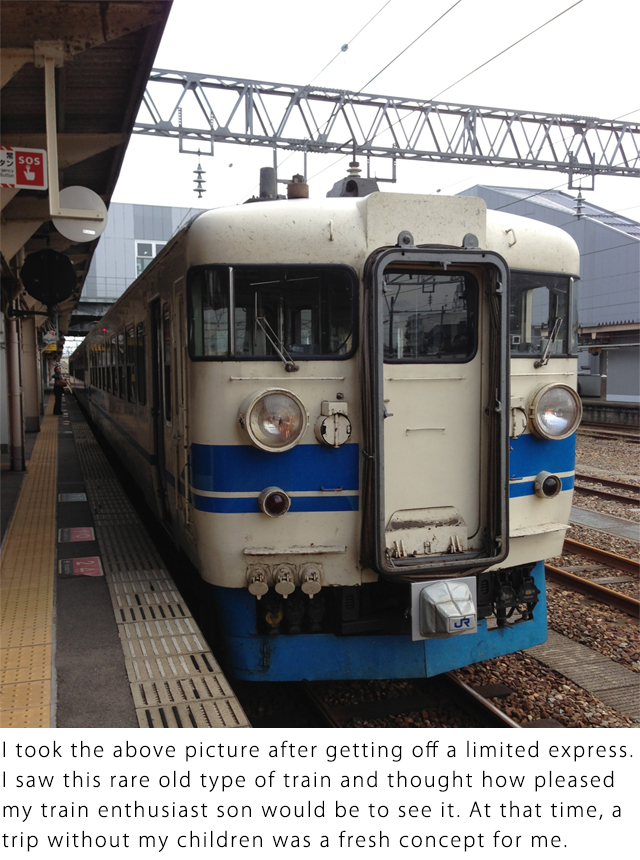 But I was impressed by his sincere attitude to manufacturing and also the trust of the designer who took the rostrum alongside him, and I admired the relationship. It reminded me of the relationship between Mr. Kurosaki from IDEE Co., Ltd and designers at one time.
But I was impressed by his sincere attitude to manufacturing and also the trust of the designer who took the rostrum alongside him, and I admired the relationship. It reminded me of the relationship between Mr. Kurosaki from IDEE Co., Ltd and designers at one time.
Anyway, visit the town. There is nothing to lose.
This was before the start of the Hokuriku Shinkansen service. On the 4-hour train journey to Toyama, I remembered that TAKATA Lemnos was a manufacturer selling clocks designed by Riki Watanabe. I made a rough sketch of “my ideal clock that I am looking for” in my mind in a sketchbook. The first sketch was a weird clock that had the numbers protruding from the clock frame.
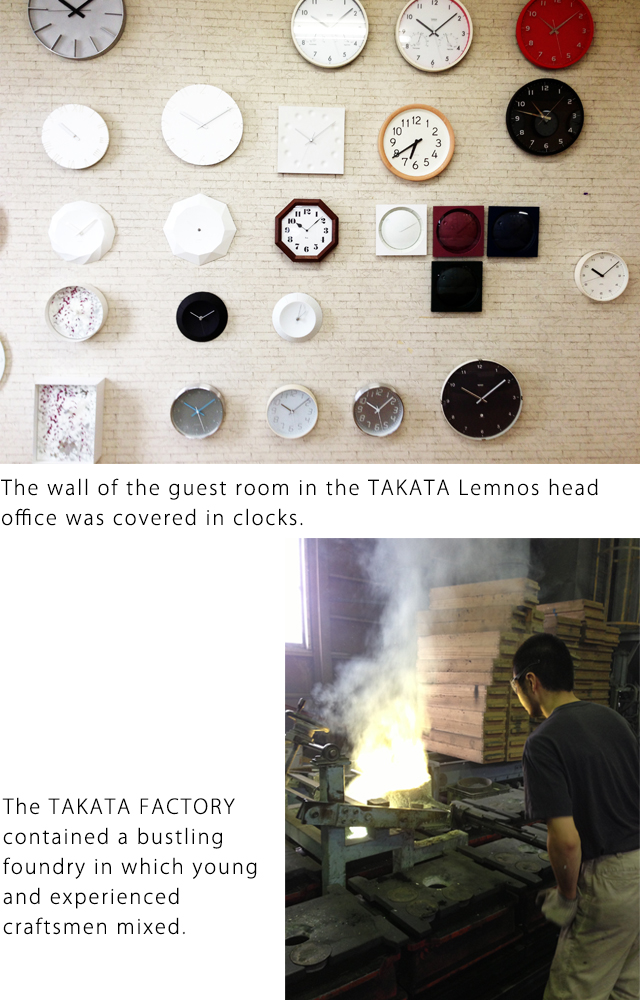 The person who came to Takaoka station to pick me up was Mr. Takata himself, the president of TAKATA Lemnos. In the car, I was excited to talk about many things, such as my request to make a prototype for the competition that I was entering at that time, the difficulty I was having in getting an ideal clock for my workshop, and the fact that it was my first time visiting a town that was far away from my family and where I did not know anybody.
The person who came to Takaoka station to pick me up was Mr. Takata himself, the president of TAKATA Lemnos. In the car, I was excited to talk about many things, such as my request to make a prototype for the competition that I was entering at that time, the difficulty I was having in getting an ideal clock for my workshop, and the fact that it was my first time visiting a town that was far away from my family and where I did not know anybody.
The Lemnos office was full of clocks. Unfortunately, even there, I was unable to find my ideal clock with numbers using base 60. When I showed him a model clock and sketch for a competition, he said, “For now, we have nothing to help you regarding the parts that you would like to make, Ms. Dobashi. But allow me to introduce a person who may be able to help you, if you don’t mind.” I accepted his kind offer. Believe it or not, he arranged a meeting with another manufacturer for me, used a whiteboard to explain the know-how for designing a clock while we waited, and then introduced the TAKATA FACTORY to me because he considered it was best for the future if I was familiar with the aluminum processing methods.
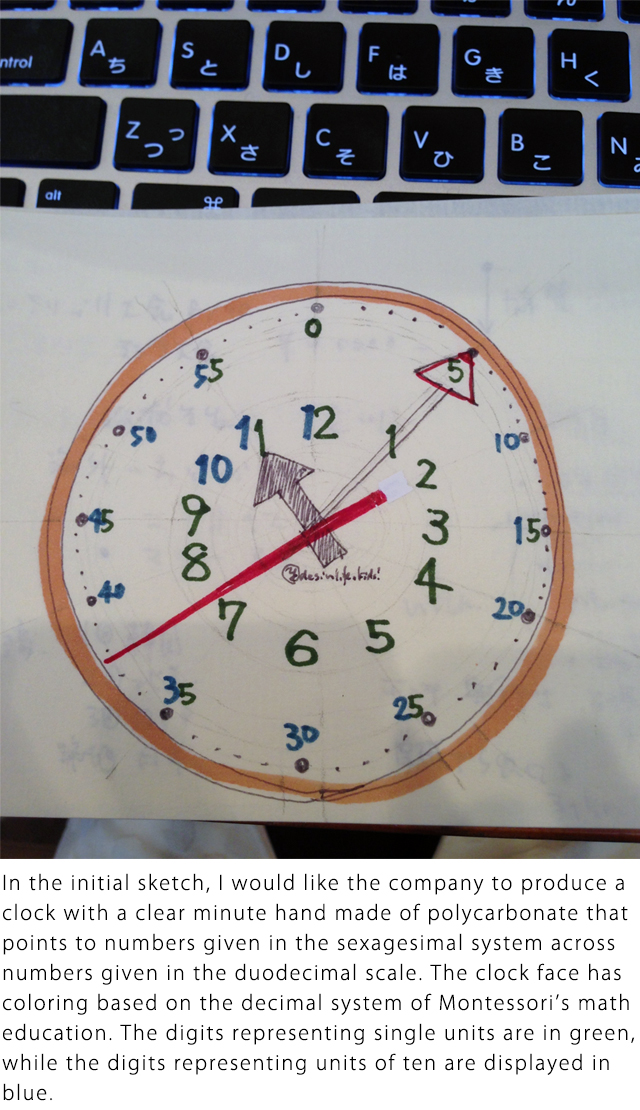 After being treated to dinner, with nothing to do in the room, I was disappointed by the fact that I wouldn’t accomplish my initial purpose and that Lemnos had no clocks with numbers using base 60. Eventually, feeling a little resentment that “they produce so many clocks but why not the one I’m looking for,” I continued to sketch a clock based on the know-how that I had acquired during the daytime.
After being treated to dinner, with nothing to do in the room, I was disappointed by the fact that I wouldn’t accomplish my initial purpose and that Lemnos had no clocks with numbers using base 60. Eventually, feeling a little resentment that “they produce so many clocks but why not the one I’m looking for,” I continued to sketch a clock based on the know-how that I had acquired during the daytime.
President Takata also took me to the station for my return journey.
“Regarding the clock for kids that you told me about, how about designing it yourself?”
“I’m no good at graphics.” graphic, so I can’t instruct them on how to do it. I just understand that the Montessori approach, with which my daughter is able to understand a clock, might be useful.”
“I see. However, you know that there are no ideal clocks around you, don’t you? Lemnos has superior staff. Based on the sketch you’ve prepared, you can use them freely. Instead, as I’m not sure what Montessori education is, would you be able to talk about it with a professional teacher at your daughter’s nursery school?”
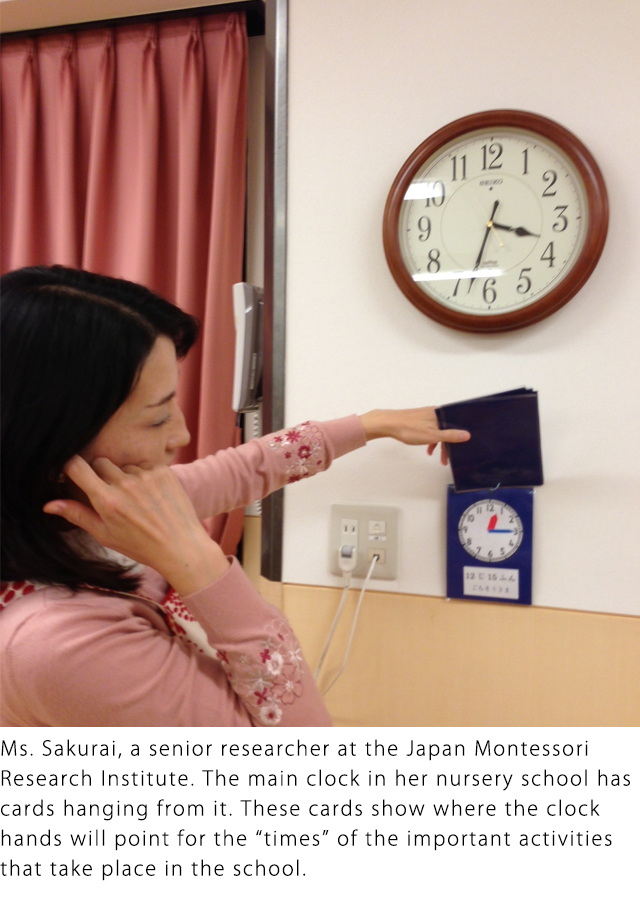
It was then that I had a light-bulb moment.
I decided to visit Ms. Sakurai, my daughter’s ex-teacher, and inquire about the process of teaching two-year-old children the concept of time and hours.
“I have no confidence in whether I am able to design it. But I do now understand what I need to do next. I’d like to try it, and I will do it.”
“Thank you, I’m looking forward to it.”
I received such a generous proposal from president Takata and parted from him feeling very satisfied. But I struggled to comprehend that I was being given the chance to design a clock for Lemnos, the famous clock company.
To be continued…

Yoko Dobashi
Yoko Dobashi spent five years working at Idee co. Ltd. (1997-2002). She was involved in the development of standard furniture and in the launch of the “SPUTNIK” brand, which was introduced in London, Milan, and New York. Since 2012 she has hosted the “Design life with kids interior workshop.” She is active independently as a freelance designer and interior writer, working in collaboration with various companies and media. In 2017 she provided design to TAKATA Lemnos and the “fun pun clock” won the GOOD DESIGN AWARD. Her article “Interior for a 156-cm-tall” is serialized at Precious.jp.
http://yokodobashi.com/


